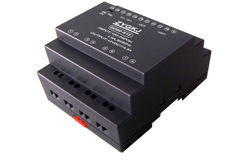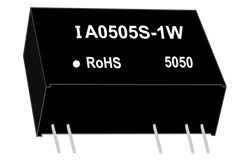বাতৰি
Exploring the Efficiency and Performance of Bidirectional DC-DC Converters
Author: ZYG Power Module Time: 2023-7-11
Introduction:
Bidirectional DC-DC converters have gained significant attention in recent years due to their ability to efficiently transfer power bidirectionally between two different DC voltage sources. These converters are crucial in various applications, including renewable energy systems, electric vehicles, and energy storage systems. This article aims to explore the efficiency and performance of bidirectional DC-DC converters, shedding light on their advantages, challenges, and potential improvements.
1. Working Principle of Bidirectional DC-DC Converters:
Bidirectional DC-DC converters, also known as buck-boost converters, use power semiconductors to convert DC voltage from a source to a desired voltage level. These converters can work in both step-up (boost) and step-down (buck) modes, allowing power to flow in either direction. By employing appropriate control algorithms, bidirectional converters enable efficient power transfer between multiple sources.
2. Advantages of Bidirectional DC-DC Converters:
2.1. Energy Efficiency: Bidirectional converters ensure efficient power transfer, minimizing energy losses during conversion. This feature is particularly crucial in renewable energy systems, where energy conservation is paramount.
2.2. Improved Stability: Bidirectional converters offer improved stability compared to unidirectional converters by allowing the transfer of power between different DC voltage sources.
2.3. Enhanced Power Flow Control: With bidirectional converters, power can be regulated and distributed appropriately, facilitating optimal power flow management in complex systems.
3. Challenges and Limitations:
3.1. Voltage and Current Stresses: Bidirectional converters may experience increased voltage and current stresses during operation, which can result in reduced efficiency and reliability.
3.2. Control Complexity: Effective control algorithms are essential for bidirectional converter operation. However, designing and implementing these algorithms can be challenging due to their complexity.
3.3. Electromagnetic Interference (EMI): Bidirectional converters can introduce high-frequency noise and EMI, which can impact the performance of other electronic components in the system.

4. Recent Developments and Improvements:
4.1. Soft-Switching Techniques: Implementing soft-switching techniques in bidirectional converters can reduce voltage and current stresses, improving overall efficiency and reliability.
4.2. Advanced Control Strategies: Advanced control strategies, such as predictive control and model-based algorithms, can enhance bidirectional converter performance and stability.
4.3. Integrated Power Modules: Integration of power semiconductor devices with other passive components can minimize parasitic elements, reducing EMI and improving overall system efficiency.
5. Conclusion:
Bidirectional DC-DC converters play a crucial role in various applications, providing efficient power transfer between multiple DC voltage sources. Despite the challenges and limitations, recent developments in soft-switching techniques, advanced control strategies, and integrated power modules have significantly improved the efficiency and performance of bidirectional converters. Further research and development efforts are needed to optimize these converters for various emerging applications, ensuring a sustainable and efficient power transfer in the future.
পূৰ্ৱবৰ্তী: Introducing the SP Series AC DC Converter: Unleashing Efficient Power Conversion
এটাৰ পাচৰ: Bidirectional DC-DC Converter: The Future of Efficient Energy Conversion
প্ৰাসংগিক তথ্য
-
2023-12-6
AC Power Supply Module: Ensuring Efficient and Reliable Energy Delivery
In today's fast-paced world, the demand for efficient and reliable energy delivery has become paramount. The AC power supply module plays a vital role in meeting this demand by converting alternating current (AC) into usable direct current (DC) for various electronic devices. This article aims to explore the importance of AC power supply modules, their components, and their role in ensuring efficient and reliable energy delivery. Components of an AC Power Supply Module An AC power supply module comprises several key components that work together to convert AC to DC power. These components include a transformer, rectifier, filter capacitor, and voltage regulator. The transformer is responsible for stepping down the high voltage AC power to a lower voltage level suitable...
সবিশেষ চাওক -
2023-7-18
Ultimate Guide to AC-DC Power Supply: Everything You Need to Know
Introduction: AC-DC power supply is a critical component in various electronic devices, ranging from small household appliances to large industrial machinery. Understanding how AC-DC power supply works and its different types is essential for anyone involved in the field of electronics. This ultimate guide aims to provide a comprehensive overview of AC-DC power supply, covering everything you need to know. 1. Basics of AC-DC Power Supply: AC-DC power supply is a device that converts alternating current (AC) into direct current (DC). AC is the type of electrical current supplied by power grids, while DC is the type of current required by most electronic devices. The conversion process involves several stages, including rectification, filtering, and voltage regulation. 2. Rectification: The first...
সবিশেষ চাওক -
2023-8-8
China ZP Series AC DC Converter: Efficient Power Conversion for Your Electronic Devices
In today's fast-paced and technology-driven world, electronic devices have become an integral part of our daily lives. From smartphones and laptops to smart home appliances and electric vehicles, these devices rely heavily on efficient power conversion to function effectively. This is where the ZP Series AC DC Converter comes into play, offering a reliable and efficient solution for powering your electronic devices. The ZP Series AC DC Converter is a cutting-edge power conversion device that ensures optimal performance and energy efficiency. It is designed to convert alternating current (AC) power from the mains supply into direct current (DC) power that is suitable for powering electronic devices. With its advanced technology and intelligent design, the ZP Series AC DC Converter can...
সবিশেষ চাওক -
2023-5-11
Online Wholesale 12V AC-DC Converter: Efficiently Powering Your Devices
In our modern world, we rely heavily on electronic devices for communication, entertainment, work, and daily tasks. These devices require a reliable and efficient power source to function properly. While many electronic devices run on batteries, they eventually run out of power and need to be recharged or replaced. A 12V AC-DC converter is a device that can efficiently power your devices without the need for constant battery replacement. An AC-DC converter is a device that converts alternating current (AC) to direct current (DC). AC is the type of current that is commonly found in power outlets, while DC is the type of current that is used by electronic devices. Most electronic devices, such as smartphones, laptops, and tablets, run...
সবিশেষ চাওক -
2023-5-7
Designing an AC-DC Converter Circuit
AC-DC converter circuits are essential components in many electronic devices such as power supplies and battery chargers. These circuits allow the conversion of AC power from the electrical grid to DC power that can be used to power electronic devices. In this article, we will discuss the design of an AC-DC converter circuit. The first step in designing an AC-DC converter circuit is to determine the input voltage and the desired output voltage. Once these values are known, the next step is to choose the appropriate transformer and rectifier components. The transformer is used to step down the input voltage to a level that is suitable for the rectifier circuit. The rectifier circuit is responsible for converting the AC voltage...
সবিশেষ চাওক -
2023-4-24
AC-DC Power Supply: The Ultimate Guide to Understanding and Choosing the Right One
An AC-DC power supply is an essential tool for powering electronic devices. It converts alternating current (AC) to direct current (DC), providing a stable and regulated voltage output. Understanding the basics of an AC-DC power supply and how to choose the right one for your needs is crucial for anyone working with electronic devices. In this guide, we will cover everything you need to know about AC-DC power supplies. AC-DC Power Supply Basics An AC-DC power supply consists of several components that work together to convert AC to DC. The main components are the transformer, rectifier, filter, and regulator. The transformer is used to step down the AC voltage from the mains to a lower voltage suitable for the rest...
সবিশেষ চাওক


















